Nithish Kannen
Proactive Agents for Multi-Turn Text-to-Image Generation Under Uncertainty
Dec 09, 2024Abstract:User prompts for generative AI models are often underspecified, leading to sub-optimal responses. This problem is particularly evident in text-to-image (T2I) generation, where users commonly struggle to articulate their precise intent. This disconnect between the user's vision and the model's interpretation often forces users to painstakingly and repeatedly refine their prompts. To address this, we propose a design for proactive T2I agents equipped with an interface to (1) actively ask clarification questions when uncertain, and (2) present their understanding of user intent as an understandable belief graph that a user can edit. We build simple prototypes for such agents and verify their effectiveness through both human studies and automated evaluation. We observed that at least 90% of human subjects found these agents and their belief graphs helpful for their T2I workflow. Moreover, we develop a scalable automated evaluation approach using two agents, one with a ground truth image and the other tries to ask as few questions as possible to align with the ground truth. On DesignBench, a benchmark we created for artists and designers, the COCO dataset (Lin et al., 2014), and ImageInWords (Garg et al., 2024), we observed that these T2I agents were able to ask informative questions and elicit crucial information to achieve successful alignment with at least 2 times higher VQAScore (Lin et al., 2024) than the standard single-turn T2I generation. Demo: https://github.com/google-deepmind/proactive_t2i_agents.
Efficient Pointwise-Pairwise Learning-to-Rank for News Recommendation
Sep 26, 2024



Abstract:News recommendation is a challenging task that involves personalization based on the interaction history and preferences of each user. Recent works have leveraged the power of pretrained language models (PLMs) to directly rank news items by using inference approaches that predominately fall into three categories: pointwise, pairwise, and listwise learning-to-rank. While pointwise methods offer linear inference complexity, they fail to capture crucial comparative information between items that is more effective for ranking tasks. Conversely, pairwise and listwise approaches excel at incorporating these comparisons but suffer from practical limitations: pairwise approaches are either computationally expensive or lack theoretical guarantees, and listwise methods often perform poorly in practice. In this paper, we propose a novel framework for PLM-based news recommendation that integrates both pointwise relevance prediction and pairwise comparisons in a scalable manner. We present a rigorous theoretical analysis of our framework, establishing conditions under which our approach guarantees improved performance. Extensive experiments show that our approach outperforms the state-of-the-art methods on the MIND and Adressa news recommendation datasets.
Beyond Aesthetics: Cultural Competence in Text-to-Image Models
Jul 11, 2024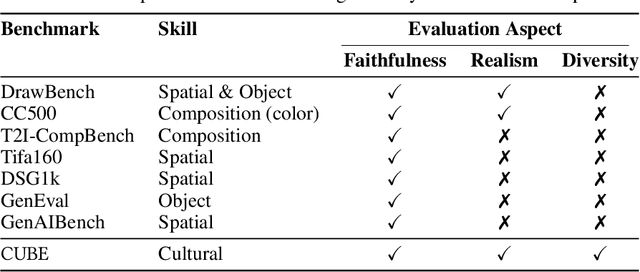
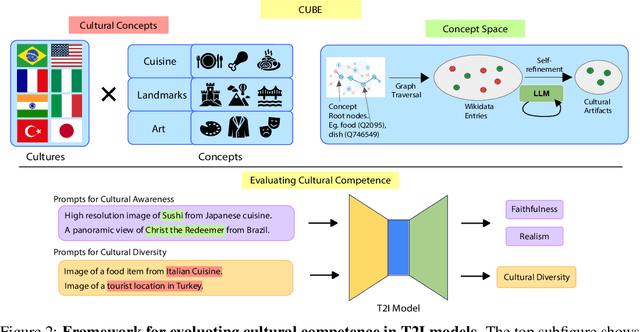


Abstract:Text-to-Image (T2I) models are being increasingly adopted in diverse global communities where they create visual representations of their unique cultures. Current T2I benchmarks primarily focus on faithfulness, aesthetics, and realism of generated images, overlooking the critical dimension of cultural competence. In this work, we introduce a framework to evaluate cultural competence of T2I models along two crucial dimensions: cultural awareness and cultural diversity, and present a scalable approach using a combination of structured knowledge bases and large language models to build a large dataset of cultural artifacts to enable this evaluation. In particular, we apply this approach to build CUBE (CUltural BEnchmark for Text-to-Image models), a first-of-its-kind benchmark to evaluate cultural competence of T2I models. CUBE covers cultural artifacts associated with 8 countries across different geo-cultural regions and along 3 concepts: cuisine, landmarks, and art. CUBE consists of 1) CUBE-1K, a set of high-quality prompts that enable the evaluation of cultural awareness, and 2) CUBE-CSpace, a larger dataset of cultural artifacts that serves as grounding to evaluate cultural diversity. We also introduce cultural diversity as a novel T2I evaluation component, leveraging quality-weighted Vendi score. Our evaluations reveal significant gaps in the cultural awareness of existing models across countries and provide valuable insights into the cultural diversity of T2I outputs for under-specified prompts. Our methodology is extendable to other cultural regions and concepts, and can facilitate the development of T2I models that better cater to the global population.
CONTRASTE: Supervised Contrastive Pre-training With Aspect-based Prompts For Aspect Sentiment Triplet Extraction
Oct 24, 2023


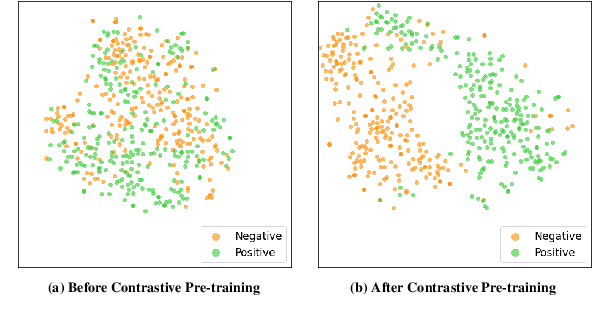
Abstract:Existing works on Aspect Sentiment Triplet Extraction (ASTE) explicitly focus on developing more efficient fine-tuning techniques for the task. Instead, our motivation is to come up with a generic approach that can improve the downstream performances of multiple ABSA tasks simultaneously. Towards this, we present CONTRASTE, a novel pre-training strategy using CONTRastive learning to enhance the ASTE performance. While we primarily focus on ASTE, we also demonstrate the advantage of our proposed technique on other ABSA tasks such as ACOS, TASD, and AESC. Given a sentence and its associated (aspect, opinion, sentiment) triplets, first, we design aspect-based prompts with corresponding sentiments masked. We then (pre)train an encoder-decoder model by applying contrastive learning on the decoder-generated aspect-aware sentiment representations of the masked terms. For fine-tuning the model weights thus obtained, we then propose a novel multi-task approach where the base encoder-decoder model is combined with two complementary modules, a tagging-based Opinion Term Detector, and a regression-based Triplet Count Estimator. Exhaustive experiments on four benchmark datasets and a detailed ablation study establish the importance of each of our proposed components as we achieve new state-of-the-art ASTE results.
Targeted Extraction of Temporal Facts from Textual Resources for Improved Temporal Question Answering over Knowledge Bases
Mar 21, 2022

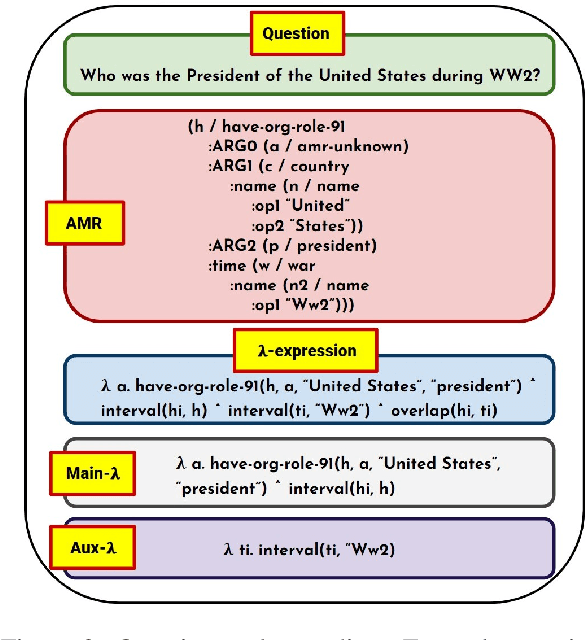
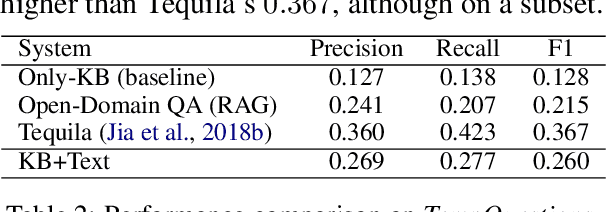
Abstract:Knowledge Base Question Answering (KBQA) systems have the goal of answering complex natural language questions by reasoning over relevant facts retrieved from Knowledge Bases (KB). One of the major challenges faced by these systems is their inability to retrieve all relevant facts due to factors such as incomplete KB and entity/relation linking errors. In this paper, we address this particular challenge for systems handling a specific category of questions called temporal questions, where answer derivation involve reasoning over facts asserting point/intervals of time for various events. We propose a novel approach where a targeted temporal fact extraction technique is used to assist KBQA whenever it fails to retrieve temporal facts from the KB. We use $\lambda$-expressions of the questions to logically represent the component facts and the reasoning steps needed to derive the answer. This allows us to spot those facts that failed to get retrieved from the KB and generate textual queries to extract them from the textual resources in an open-domain question answering fashion. We evaluated our approach on a benchmark temporal question answering dataset considering Wikidata and Wikipedia respectively as the KB and textual resource. Experimental results show a significant $\sim$30\% relative improvement in answer accuracy, demonstrating the effectiveness of our approach.
CABACE: Injecting Character Sequence Information and Domain Knowledge for Enhanced Acronym and Long-Form Extraction
Dec 25, 2021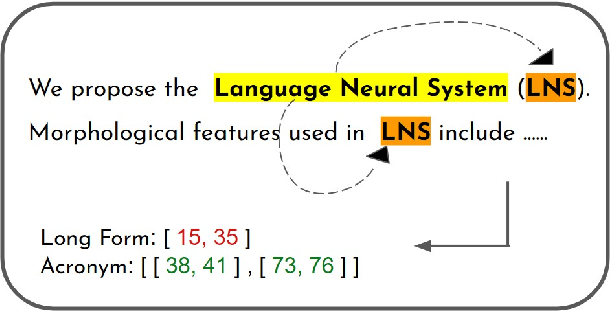

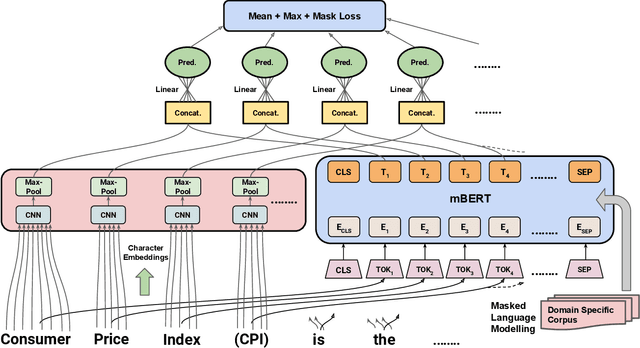
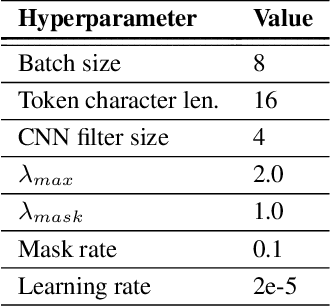
Abstract:Acronyms and long-forms are commonly found in research documents, more so in documents from scientific and legal domains. Many acronyms used in such documents are domain-specific and are very rarely found in normal text corpora. Owing to this, transformer-based NLP models often detect OOV (Out of Vocabulary) for acronym tokens, especially for non-English languages, and their performance suffers while linking acronyms to their long forms during extraction. Moreover, pretrained transformer models like BERT are not specialized to handle scientific and legal documents. With these points being the overarching motivation behind this work, we propose a novel framework CABACE: Character-Aware BERT for ACronym Extraction, which takes into account character sequences in text and is adapted to scientific and legal domains by masked language modelling. We further use an objective with an augmented loss function, adding the max loss and mask loss terms to the standard cross-entropy loss for training CABACE. We further leverage pseudo labelling and adversarial data generation to improve the generalizability of the framework. Experimental results prove the superiority of the proposed framework in comparison to various baselines. Additionally, we show that the proposed framework is better suited than baseline models for zero-shot generalization to non-English languages, thus reinforcing the effectiveness of our approach. Our team BacKGProp secured the highest scores on the French dataset, second-highest on Danish and Vietnamese, and third-highest in the English-Legal dataset on the global leaderboard for the acronym extraction (AE) shared task at SDU AAAI-22.
 Add to Chrome
Add to Chrome Add to Firefox
Add to Firefox Add to Edge
Add to Edge